Abstract
In coal mine roadway support, the arrangement of roadways in areas with high-stress concentrations is a challenging issue. It is crucial to solve this problem in order to ensure the safety and productivity of the mine. In this study, we selected a typical roadway in Zhong Xing Coal Mine, Fen Xi, Shanxi Province, as our research focus. We analyzed the deformation and failure characteristics of the surrounding rock under field mining pressure during roadway excavation through theoretical analysis, numerical simulation, and on-site measurements. Using the Flac3D numerical simulation technique, we studied the stress distribution characteristics of the roadway in the stress concentration area. To address the significant deformation of the roadway, we proposed a high-pretensioned top beam high-strength dual-anchor truss support system (HSCTS) and carefully studied its control mechanism and structural characteristics. After simulating and comparing its support effectiveness with the original support scheme and conducting on-site industrial tests, we determined the HSCTS support system as the alternative support system for roadway 1409. The test results showed that the convergence of the rib plates and the roof was no more than 79 mm and 191 mm, respectively. The significant influence of the roadway on the control of the surrounding rock also indicated effective control of the surrounding rock’s deformation along the 1409 goaf. The support control technology system can provide specific reference values for roadways under similar geological production conditions.
1. Introduction
Based on the resource endowment conditions of having a relatively rich coal reserve, a poor oil reserve, and a limited natural gas reserve, it is expected that coal will continue to play a dominant role in China’s energy system in the near future [1]. The stability of coal roadways poses numerous complex and challenging issues, particularly in high-stress areas that are subjected to repeated mining activities. However, due to the substantial increase in coal production, many mining locations are experiencing a rise in coal mining intensity. Consequently, the surrounding rock of the coal roadways often undergoes significant deformation and failure, which is a frequent problem. Therefore, it is crucial to conduct relevant research on the deformation characteristics of coal roadways and develop effective control strategies.
When it came to the stability control of roadway surrounding rock, prior literature mainly concentrated on complex production geological conditions, such as deep high stress, large sections, geological structures (such as faults), extra thick coal seams, thick mudstone composite roofs, and proposed control countermeasures under various circumstances [2,3,4,5]. The adoption of support modification pressure relief collaborative control technology was suggested by Kang et al. [6]. He and his collaborators [7] advocated using anchor control technology with substantial deformation and steady resistance. A square steel (steel tube) concrete support is suggested in light of the deep, high-stress, dynamic-pressure roadway [8,9,10,11]. Utilizing a truss control system was suggested by Yan et al. [12]. The zoning joint control technology was proposed by Wang et al. [13]. The application of prestressed synergistic support technology was suggested by He et al. [14]. Long anchors, stiff long rebar bolts, anchor nets, W steel belts, and shotcrete were suggested by Yuan et al. [15] as the major body of a comprehensive control technology that can be attached to long anchors to strengthen the roof plate. According to Yu et al.’s [16] proposal, the surrounding rock of the roadway was supported in zoning on the basis of drilling and depressurizing it. Liu et al.’s [17] stepwise reinforcement and support approach was based on the expansion of the spatio-temporal relationship of the plastic zone in the recurrent mining operation.
However, the majority of coal roadways are situated in areas with high levels of mining stress. This means that when the roadway is excavated, the surrounding rock becomes damaged. If the correct support technology is not used, this can result in significant deformation of the roof plate, leading to accidents such as roof destabilization and collapse. The initial excavation and repair of these roadways is particularly challenging and time-consuming because they often require frequent fixes, sometimes even in the same location. This circumstance makes it difficult to ensure the safety of coal mine production during the excavation process and requires personnel to regularly repair the considerable deformation risk zone in the surrounding rock.
Numerous numerical simulations have been constructed and used recently to analyze the mechanism of roadway instability. Numerical approaches to research have the benefits of being inexpensive, very effective, and highly reproducible. Numerous case studies and numerical techniques for various applications confirm that modeling the failure mechanism is feasible. Gao et al. [18] suggested the UDEC Trigon technique and simulated the evolution features of the surrounding roadway deformation, including crack development, roof displacement, damaged coal side zones, etc. Stability analysis of surrounding rock in a mining roadway. In order to analyze the primary influencing factors of the mining-induced vertical and horizontal stresses as multiple coal seams advanced sequentially, Suchowerska et al. [19] and Suchowerska et al. [20] conducted a numerical simulation. They also discussed the appropriate layout of roadways based on stress distribution conditions. Su et al.’s [21] simulation of the overburden movement characteristics during working face advancement revealed that tensile stress promoted the spread of numerous new fractures, lowering the strength of the rock strata and weakening the stability of the adjacent roadway. Three types of stress distribution circles, including stress decrease circles close to the mining working face, ground stress circles outside of the mining zone, and stress growth circles between the decrease and ground stress circles, were obtained by Yang et al. [22] from a simulation of the multiple coal seam mining process. As the working face moved through the above desert roadway and coal pillar, Li et al. [23] and Gao et al. [24] examined the features of the evolution of mining-induced stress. They came to the conclusion that the intense mining-induced stress had a substantial impact on the deformation of the nearby roadway. Karst-abrupt water numerical analysis by Zhao et al. [25] To examine the stability of water-resistant rock pillars, a linkage analysis between the hydro-mechanical coupling and the strength reduction approach was performed. In engineering practice, a criterion for determining the necessary width of the pillar was proposed, and the pillar’s factor of safety (FOS) was established. To explore the combined seepage-damage effect in fractured rock masses, Zhao et al. [26] offer a dual-medium model with equal continuous and discrete fracture media. An instance of high-pressure water injection in a coal seam has been explored to show how the new model might be used and how the damage in the coal seam evolved. A series of direct shear experiments were conducted on three different types of natural rock joints, and Zhao et al. [27] constructed a new strength model of natural rock joints. The suggested FRC-JCS shear strength model, which can more thoroughly describe the contribution of joint surface morphological factors to shear strength, is in better accord with the experimental results when compared to the previously reported shear strength models. Yu et al. [28] used field investigation techniques, laboratory experiments, and theoretical analysis to evaluate the mechanical properties and deformation control strategy of the roadway with a poorly cemented siltstone roof. The weakly cemented siltstone was discovered to be made up of coarse-grained minerals with a high degree of pore development using a scanning electron microscope. On the basis of grout reinforcement, a combined support plan is proposed. A strongly cemented siltstone roadway’s surrounding rock deformation can be efficiently controlled by a support system. Sakhno I et al. [29] studied the foreheave evolution and rock bolt reinforcement technology as examples. A numerical simulation was used to study the stress–strain state and displacement of surrounding rocks. It was found that significant fjord heave was caused by nonlinear deformation of laminated immediate fjord under an increase in rock fracturing. Post-peak strain regions merge in the central part of the roadway fjord, which is the cause of uncontrolled fjord heave. G. Guo et al. [30] revealed through numerical simulation, laboratory physical simulation, and engineering practice that the surrounding rock of the mining roadway underwent expansion deformation. The reinforcement of the roof and sidewalls redistributed the stress in the surrounding rock. The physical simulation showed that strengthening the coal seam roof and sidewalls reduced the separation of the floor and decreased floor displacement. The cable support is commonly used both in static and dynamic conditions, and the optimal design solution is still being sought to develop the support reinforcement factor, by means of which it will be possible to optimally select the support protecting the excavation against loss of stability [31,32].
The literature mentioned above primarily focuses on the distribution of stress during the sequential advancement of multiple coal seams in the mining process. It also examines the relationship between stress distribution and the stability of surrounding roadways. However, there have been limited studies on roadway excavation in stress concentration zones. This study selected a roadway (named 1409) that experienced a high-stress concentration to investigate the deformation characteristics of surrounding roadways during the excavation process. The study also aimed to understand the reasons for the formation of high-stress zones. Based on the deformation observed in the surrounding roadways, we proposed an innovative support scheme called high-pretensioned HSCTS (High-Strength Dual-Anchor Truss Support). This scheme was successfully implemented on a coal mine roadway and demonstrated its effectiveness in maintaining the stability of the surrounding roadways.
2. Overview of Test Roadway Project
The connection between the goafs of the 10,209 working face, the 1211 working face, and the 1411 working face is illustrated in Figure 1. Mining operations primarily take place on working face 1411, where coal seam 4 is predominantly extracted. Working face 10,209 serves as the main mining location for coal seam #02. There is a distance of 21 m between the ceiling pillar of the 1409 airway and the haulageway floor of working face 10,209. The average thickness of coal seam #02 is 1.3 m. The 1409 airway has an average depth of 480 m. Coal seam 4 has an average thickness of 2.3 m and a dip angle of 7°. The roadway spans a length of 1352 m, with a separation of 16 m between Section I of the 1409 airway and the 1411 haulageway and a separation of 28 m between Section II. The middle roof consists of argillaceous shale and fine sandstone, each with a thickness of 1.8 m, while the direct floor is made up of carbonaceous mudstone and has a thickness of 0.5 m. The coal rock histogram of working face 1409 is depicted in Figure 2.
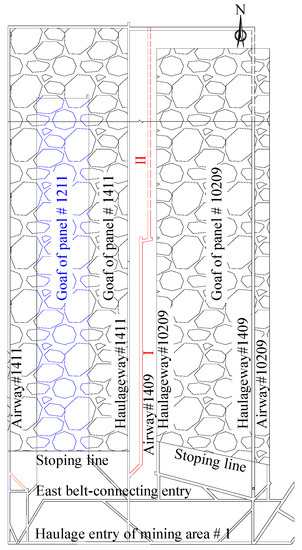
Figure 1.
Roadway layout of the 1409 working face.
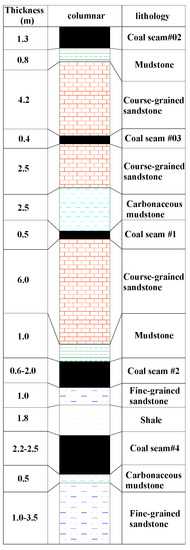
Figure 2.
Schematic diagram of the stratum structure.
The 1409 airway, which is driven along the roof of the #4 coal seam, has a width of 4200 mm and a height of 2800 m. During the excavation of the roadway, the 1409 airway, which is located above the #4 coal seam, experienced significant deformation due to the high-stress concentration caused by the adjacent workface 1411 and the side upper workface 10,209. As a result, the initial support scheme had to be changed three times in order to address the impact of the high-stress concentration area. To improve the stability of the rock surrounding the roadway, a reinforcement strategy was implemented. This strategy includes four main support schemes. Each hole is anchored using two K2355 resin cartridges and two Z2355 resin cartridges, along with Φ 22 × 2400 mm strong deformed steel bolts. A pre-tightening torque of at least 300 N·m is required. Additionally, metal mesh with a size of 9100 × 900 mm and a row spacing of 780 × 800 mm is used. The roof anchor cable is arranged in a 3–4–3 pattern with a length of Φ 21.6 × 7300 mm. The distance between three anchor cables is 1400 mm, and the distance between anchor cables on either side of the road is 700 mm. The anchor cables are placed at a distance of 1000 mm from each other when four cables are constructed. Each hole in the side anchor bolt is filled with a roll of Z2355 capsule resin, and a minimum pre-tightening tension of 200 N·m is required. For the two-sided construction, a steel strand anchor cable with a diameter of Φ 21.6 × 4500 mm is used. One anchor cable is built on each side of the coal wall, positioned 1200 mm away from the top plate and with a row spacing of 1600 mm. The side anchor cable is aligned with the top anchor cable. Both sides of the anchor cables are inclined at an angle of 70° with the ceiling, and the row spacing is 900 mm. The 600 mm between the two sides of the anchor cable and the road is supported by a 3400 mm-long W steel strip. The support plan was created during road excavation, as shown in Figure 3.
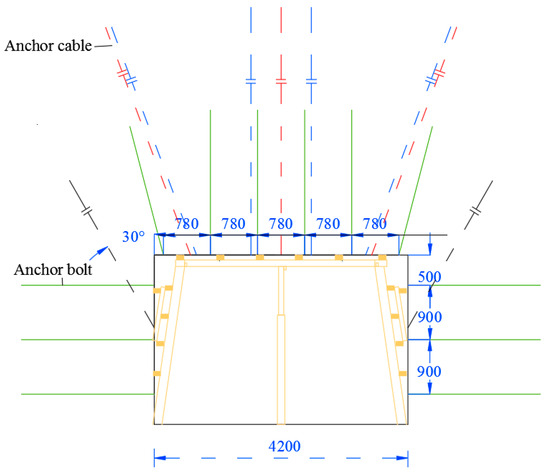
Figure 3.
1409 airway presents support technical scheme.
The excavation has caused significant subsidence in the roof, substantial damage to the floor and sides of the roadway, with an approach of more than 1.8 m between the roof and floor, a retraction of up to 1.1 m on both sides, and an overall outward movement of the roof. To ensure regular use of the road during mining, a passive approach of “digging before and repairing after” was adopted, and 1409 working faces were repaired 4–5 times prior to mining.
3. Deformation and Failure Characteristics of Surrounding Rock of Roadway
During the excavation of the entry, we conducted comprehensive field monitoring to assess the stability of the 1409 airway. This monitoring included various measures such as entry convergence monitoring, bedding separation in roof strata (BSRS) monitoring, and bolt and cable load monitoring.
To measure entry convergence, we used flexible tape and telescoping rods to monitor the convergence between ribs and between the roof and floor. The distance between nearby convergence points was 25 m. We also installed rib pigs 1.4 m away from the floor to monitor rib-to-rib convergence and roof and floor pigs in the mid-span of the roof and floor to monitor roof-to-floor convergence.
For BSRS monitoring, we used the GYW300 monitoring device (Tai’an Jiufang Mining Equipment Co. Taian China). The distance between nearby BSRS stations was 50 m, with a shallow point of 2.5 m and a deep point of 8.5 m.
To monitor bolt and cable loads, we used typed MJ-40 and MJ-60 load-measuring devices. These devices were installed on the third roof bolt away from the entity rib and the middle cable in the row. The distance between nearby load monitoring points was 50 m. The mine pressure monitoring station in 1409 airway is shown in Figure 4.
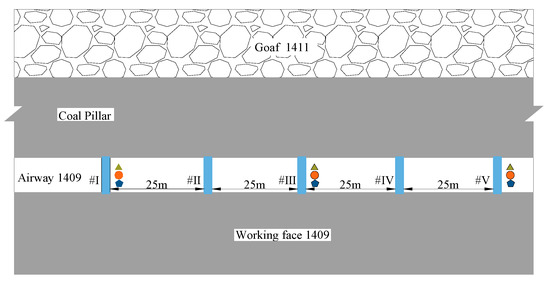
Figure 4.
Mine pressure monitoring station in 1409 airway.
3.1. Deformation Law of Roadway Surrounding Rock
During the excavation of airway #1409, I analyzed the convergence between the roof and floor as well as the convergence between the ribs. I selected a typical measuring point to study the changes in monitoring data. In Figure 5a, you can see the monitoring results of airway #1409 during the excavation period. The largest convergence between the roof and floor was 1880 mm, while the largest convergence between the ribs was 1100 mm, both occurring after 189 days of excavation.
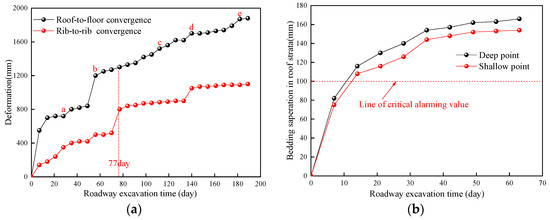
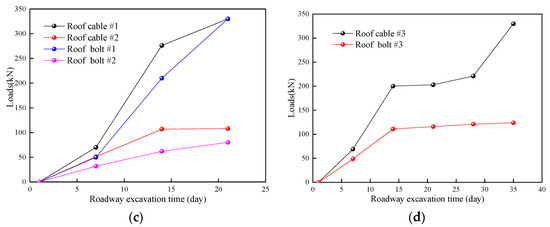
Figure 5.
Evolution characteristics of the deformation and supporting loads of the surrounding roadway rock. (a) surrounding roadway deformation; (b) the BSRS; (c,d) loads of cables and bolts.
The deformation of the surrounding rock was significant, with rapid growth rates of both roof-to-floor convergence and rib-to-rib convergence in the initial 77 days. During this time, the roof-to-floor convergence reached 1300 mm and the rib-to-rib convergence reached 800 mm, indicating substantial deformation in the surrounding area during the excavation. However, the roof-to-floor convergence and its growth rate were much larger than the rib-to-rib convergence.
As a result of the significant deformation during the excavation, there were five repair activities labeled as a, b, c, d, and e in Figure 5a. Among these activities, reducing the floor thickness was a common countermeasure. Table 1 summarizes the five reductions in floor thickness, with the largest reduction being 550 mm. This required a considerable amount of supporting materials and labor. Unfortunately, even with these repair activities, the roof-to-floor convergence did not stop, and the deformation continued to grow rapidly.

Table 1.
Floor heave of the surrounding rock deformation monitoring station #3.
The results of the monitoring of the separation layer of the roof are presented in Figure 5b. The shallow point has a maximum separation value of 155 mm, while the deep point has a maximum separation value of 167 mm. It takes 14 days for the roof separation value to exceed the critical threshold. Statistical analysis of the on-site roof separation values indicates that most of them are greater than 100 mm, with some even exceeding 200 mm. This significant separation layer on the roof, along with its instability, provides additional evidence that the support plan for the roof is inadequate in dealing with the high-stress concentration in the area.
The variations in load for the bolts and anchor cables during roadway excavation are shown in Figure 5c,d. The load on the anchor cable increases rapidly, reaching a maximum load of 330 kN. The 1 and 2 m anchor cables reached a load of 330 kN in just 27 days. The load on the anchor bolt, on the other hand, has a maximum load of 124 kN. The load on the anchor cable and the anchor bolt exhibit different patterns. While the load on the anchor cable increases quickly and can reach higher values, the load on the anchor bolt remains relatively low. These results indicate that the combined action of the anchor cable and bolt support is not effective, leading to increased stress on the roof anchor cable and subpar support from the anchor bolt. Additionally, due to the significant difference in weight between the two components, the anchor cable is damaged by the mining stress before the anchor bolt.
3.2. Analysis of Roadway Damaged Characteristics
The maximum load capacities of the cable and rod bolt supports are 454 kN and 240 kN, respectively. They were installed in sections. Failure of a supporting structure can be classified into six main categories: bending of I-beams, ripping of steel strips, fracture of bolts and anchor cables, and loosening of bolts and anchor cables. Most broken bolts fail due to tension, as shown in Figure 6a,b. In the anchor cable, only one or two steel strands break instead of the entire strand, as shown in Figure 6c. Loose anchor bolts or cables often detach the tray from the roof or coal wall surface (Figure 6d,f), and some loose anchor cables are secured to the tray (Figure 6e). The most common cause of roof steel strip tearing is shear failure (Figure 6g). Bending failure of the I-beam support structure is often caused by significant ceiling sinking during roadway excavation (Figure 6h).
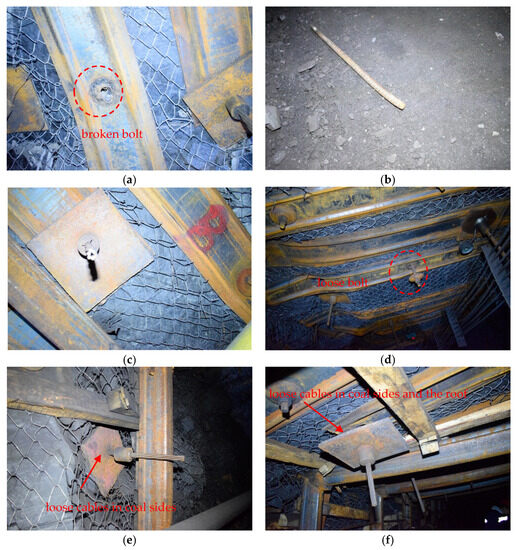
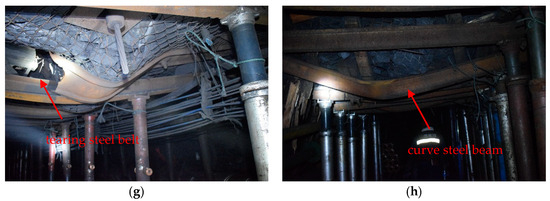
Figure 6.
Characterization of damage to roadway support structures. (a,b) broken bolt; (c) broken cable; (d) loose bolt; (e,f) loose cables in coal sides and the roof; (g) tearing steel belt; (h) curve steel beam.
Despite implementing the expanding support strength plan to prevent deformation of the surrounding rock in the 1409 airway, the combined effect of the anchor, mesh, and cable-I-steel support is still not optimal. Based on the results of above-ground pressure monitoring, the roadway continues to experience significant deformation, roof separation, and a high load on the top anchor cable throughout the construction process. After closely examining the challenging geological conditions, support configuration, and damage to adjacent rocks in the 1409 airway, the following main problems were identified:
- (1)
- The support from the upper wall has limited effectiveness. The bottom plate lacks support, and the support strength on the sides is significantly lower than the overall support strength on the roof. As a result, the roof, floor, and sides of the roadway gradually deform under the high mining stress.
- (2)
- There are significant differences between roof bolts and anchor cables. As the support strength increases during roadway excavation, the difference in support strength between anchor cables and anchor bolts becomes more pronounced. This leads to excessive stress on the anchor cables and very low stress on the anchor bolts during the initial stages of roadway construction. Additionally, the small anchoring area of a single anchor cable and the practice of combining roof anchor cables greatly reduce the effectiveness of the anchor cables.
3.3. Analysis of Stress Concentration Area in Roadway
In this section, we will analyze the stress distribution characteristics of the 1211, 10,209, and 1411 working faces of Zhongxing Coal Industry after the mining process. We will use three-dimensional numerical software (Version 5.0, Itasca Consulting, Inc., USA)to examine these characteristics. The model consists mainly of displacement boundaries and stress boundaries. The stress boundary represents the gravitational forces of the rock layers that are not included in the simulated roof rock layer. The displacement boundary is defined as X = 0, 500 m, Y = 0, 400 m, and Z = 50. These boundaries are specified as fixed displacement bounds. Additionally, the top of the model will have a downward vertical tension of 7.82 MPa applied to it, based on calculations. To simplify the geological circumstances of the site, the size of the three-dimensional numerical model is established as length × width × height = 500 m × 400 m × 290 m. The size of the working face of the model 1409 airway is shown as width × height = 4200 mm × 2400 mm in Figure 7. The model consists of 1,695,456 nodes and 1,590,625 units. By incorporating the displacement boundary and stress boundary conditions with other elements, we can determine the boundary settings of the numerical model. The schematic of the numerical model is presented in Figure 8.
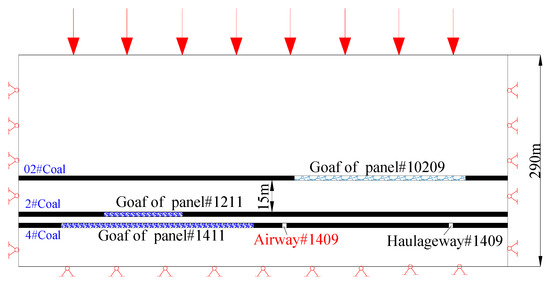
Figure 7.
Numerical model location relationships and boundary conditions.
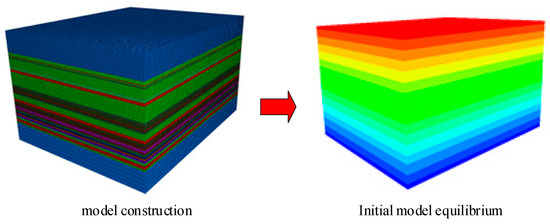
Figure 8.
Numerical calculation model.
Because rock is an elastic–plastic material, the Mohr–Coulomb criterion for the ideal elastoplastic body is used to judge the deformation and failure of rock.
In this formula, σ1 and σ3 are the maximum and minimum principal stress, respectively, c is the adhesive force, and φ is the friction angle. When fs > 0, the material will undergo shear failure and strain softening. Under normal stress conditions, the tensile strength of the rock mass is very low; thus, one can judge whether the rock mass has tensile failure according to the tensile strength criterion (σ3 ≥ σT).
Table 2 displays the numerical simulation’s rock strata parameters. The physical and mechanical properties of the coal rock are used to perform experimental measurements on the numerical simulation parameters.

Table 2.
Mechanical parameters of coal and rock layers in the calculation model.
To monitor changes in stress, we will excavate working faces 1211, 1411, and 10,209. By analyzing the records, we can determine the distribution of vertical stress in the hollow area created by mining these faces. We will also study the changes in lateral stress in the coal pillar of the 1409 airway. Along the edge of the 1411 extraction zone, we will place stress monitoring points every 3 m. The measuring line will be 36 m long, and we will use FLAC’s histogram command flow to record the stress values at the monitoring points.
Figure 9 shows the stress distribution features of airway 1409 during the excavation of working faces 1211, 10,209, and 1411. After mining these faces, both the vertical and horizontal strains increase. There are two zones of stress rise, with peak values of 29.9 MPa and 25.2 MPa, respectively, along the side of the coal pillar of the working face. These zones are 18 m apart. At a distance of 28 m from the coal pillar side, there are 1409 airways that experience stress. Sections I and II of the 1409 airway have high-stress zones due to the combined horizontal and vertical stresses in the stress rise zone.
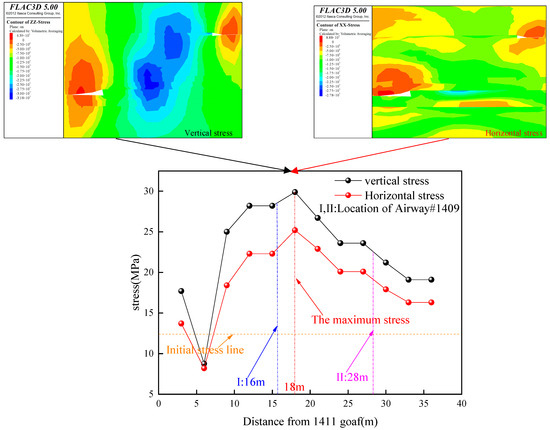
Figure 9.
Characteristics of the stress concentration area distribution and changing rule.
4. High Strength Prestressed Anchor Cable Truss Support System
4.1. Support Structure and Mechanism Analysis
- (1)
- Concept and design of truss anchor cables
The comprehensive high-strength cable truss system (HSCTS) was proposed as a solution to address the primary support issues of the airway. Figure 10 illustrates the system, which consists of inclined anchor cables on both sides connected through a special connector in the middle of the roof. The stability of the roof area is ensured by fixing it with resin cartridges. To control the system, the upper section needs to be equipped with two inclined, short anchor cables on the same channel steel. Resin cartridges are necessary to secure the stable portions between the top plate and the upper part, as well as between the upper part and the bottom plate. Additionally, large-diameter steel strands with high preload are used for the roof and coal slope anchor cables. The support systems for the roof and coal wall, located in the same section of the road, together form the complete support structure for the roadway.
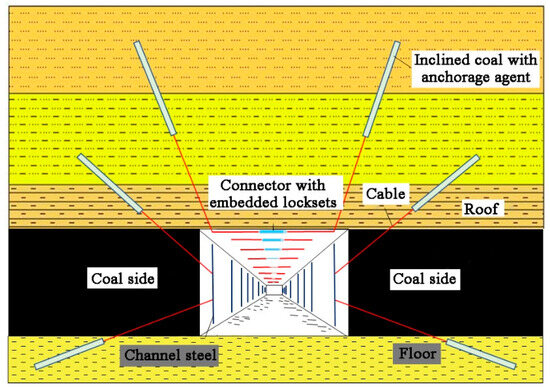
Figure 10.
Overall layout of HSCTS support system.
The figure labeled Figure 11 displays the top wall double anchor cable truss system. Figure 12 shows a schematic of the twin anchor cable truss support specifically for the top wall. This system consists of four different types of minor structures. Structure I is made up of lengthy anchor cables and specialized connections. Structure II primarily consists of short anchor cables, channel steel, and anchor cable locks. Structure III is composed mostly of long roof anchor cables and short upper anchor cables on both sides of the road. Structure IV is primarily composed of short lower anchor cables on both sides of the road. The key components of each structure are as follows: 1: long anchor cable; 2: short anchor cable; 3: coupling; 4: channel steel; 5: anchor rope lock.
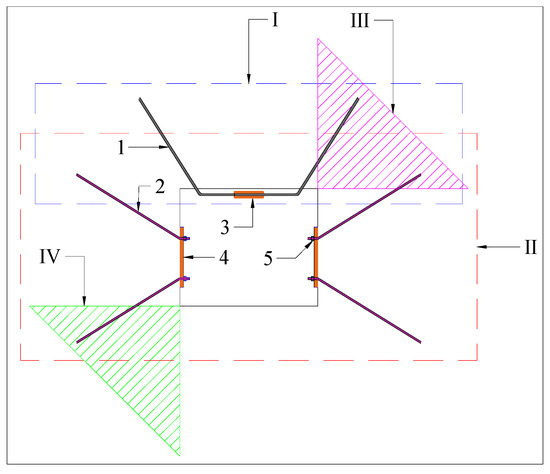
Figure 11.
Diagram of the four support structures of HSCTS.
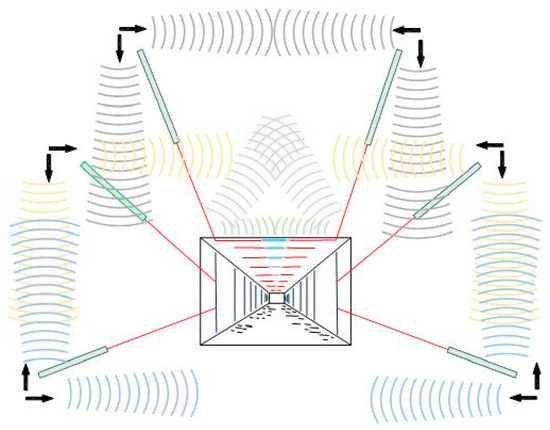
Figure 12.
Mechanism of action of HSCTS support system.
Structure I utilizes two slanted, high-strength anchor cables to support the roof instead of a single cable. The anchor point of the cable is stable due to the high preload of the connector, creating a fixed structure. This type of support strengthens the shallow roof both vertically and horizontally, effectively controlling damage caused by tensile stress during roadway excavation. The inclined, long anchor cable in this structure provides support to a range of roof strata and plays a crucial role in shear resistance. Additionally, the linear contact between the roof and the anchor cable increases the shallow pressure area and enhances stability, preventing significant deformations and roof failures.
Structure II is a conventional support structure made of channel steel and two high-strength anchor cables with high preload, similar to the roof support structure. Compared to a single anchor cable, this construction offers a wider support range and a stronger supporting impact. The anchor points for the cables are situated in a deep, stable area, ensuring successful management of coal wall stability.
Structure III consists of a large anchor cable near the roof and two high-strength, short anchor cables near the roof. It provides support for both the coal wall and the roof. This structure is particularly effective in improving shear resistance at the top corner of the roadway, which experiences large shear stresses, especially under heavy mining stress. The dispersion of anchor points between deep and shallow areas helps limit damage to the rock strata from significant shear stress.
Structure IV involves a sloped steel trough fixed into the rock strata beneath the road on one side, connected to a high-strength anchor cable. The combination of coal wall and floor support management successfully reduces roadway floor heave.
By using the shelf support structure for the top bands and a special connector to connect the top boards to the support structure, the HSCTS support system suggested in this article differs from the conventional grid support system’s innovation in that the bands are connected to the synergy control using specialized stainless steel.
- (2)
- Analysis of the truss anchor cable’s mechanics [33]
Truss anchor cable differs from standard anchor cable due to the neutral axis of the anchor solid. There are separate tensile and compressive elastic moduli in the exposed coal rock mass. Let E1 and E2 represent the compressive and tensile elastic moduli, respectively, of the bending deformation of a rock beam, as shown in Figure 13.

Figure 13.
The cross section of different elasticity modulus.
The planar assumption condition determines the bending deformation of the rock beam under the small deformation condition, and the longitudinal line strain of the rock beam varies along the height of the beam in accordance with the linear law.
The cross section’s tensile and compressive stresses are
By setting the neutral axis’ z position’s distance from the cross-section’s top and bottom edges to h2 and h1, respectively, it is possible to determine the axial force acting on the cross-section, starting with a value of 0.
A is the cross-sectional area in this case.
Equation (4) is produced by substituting Equation (3) into it.
Since h1 + h2 = h, combining it with Equation (5) will reveal the location of the neutral axis.
Equation (6) show that the neutral axis of the rock beam is not located on the symmetry axis of the cross section of the rock beam because the tensile and compressive elastic moduli of the rock beam differ. The neutral axis position and tensile modulus of the rock beam are associated if the top slab of the road is thought of as a curved rock beam. The section that follows illustrates how the alteration in the force condition of the truss anchor cable support changed the rock modulus of the rock body of the roof slab.
According to the aforementioned study, the roof slab being supported by the truss anchor system is simultaneously under three different types of compressive stress: horizontal, vertical, and longitudinal. According to the engineering mechanics literature [34], the law of elastic modulus reduction in the three-way compressive stress state of a rock beam (relative to one-way compression) is true.
where Nc is the vertical axial external force acting on the rock beam, k is the lateral pressure coefficient perpendicular to Nc’s direction of action, and vc is the Poisson’s ratio of the rock body. E and Ec represent the compressive modulus of elasticity under one-way compressive force and three-way compressive stress, respectively. Ac stands for the cross-sectional area of the rock beam, Dc for the equivalent cross-sectional radius, and uc for axial deformation.
Equation (7) demonstrates that as the rock beam of the roof transitions from a unidirectional to a three-way stress condition, the compressional elastic modulus of the rock beam obeys a certain discount law. Geological production characteristics peculiar to the Zhongxing mine include E = 3.75 MPa, Nc = 2.56 kN, k = 0.75, vc = 0.29, Ac = 2.3 m2, Dc = 0.85 m, and uc = 0.02. We obtain Ec = E1 = 1.16 MPa by substituting the aforementioned numbers into Equation (7). d = 2.3/2 − h1 = 0.4 m is the neutral axis’s downward shift.
By considering the change in stress state of the roof slab when supported by a truss anchor cable, it has been observed that the anchor solid undergoes a transition from unidirectional stress to three-way stress. This leads to a decrease in the compression modulus of the anchor solid and an increase in h2 in Equation (6). Consequently, the compression zone expands, and the neutral axis shifts.
The truss anchor cable offers several advantages, such as long soft shear resistance, a stable anchorage point located in deep and stable rock at the top corner of the roadway, and linear load bearing where the truss anchor cable is in direct contact with the top plate of the roadway. Figure 14 provides a visual representation of these benefits. As the rock in the anchorage region deforms due to the weight of the underlying rock layer, the truss anchor cable system gradually tightens and locks, creating a “groove-type” locking structure with the truss anchor cable acting as the boundary.
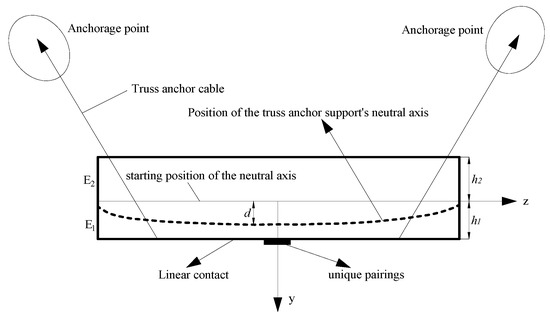
Figure 14.
Schematic diagram of neutral axis moving.
4.2. Truss Anchor Cable Numerical Simulation and Support Scheme
- (1)
- Model building
The length of the anchor cable is set at 9.4 m. The inclined part of the anchor cable is set to 8 m, and the horizontal part is set to 2.1 m. The preload force on the anchor cable is set to 200 kN. We are simulating the upper boundary stress of the 1409 airway by excavating the model. The roadway has a width of 4.2 m and a height of 2.8 m. The model consists of 15 layers of rock strata arranged from top to bottom. We will be using the Mohr–Coulomb intrinsic structure model and assigning material characteristics to each rock layer. The initial equilibrium will be calculated using the numerical model. The numerical model of the roadway support structure is shown in Figure 15.
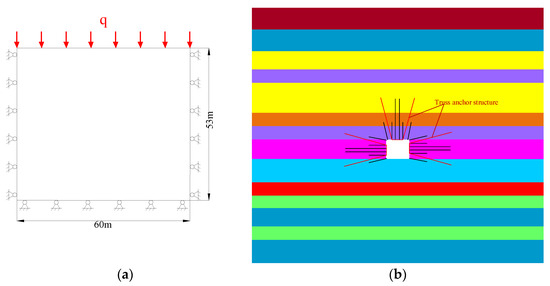
Figure 15.
Numerical model of roadway support structure. (a) Model dimensions and boundary conditions (b) Support structure model.
- (2)
- Analysis of the anchor cable pre-stress field
Characteristics of prestress distribution of HSCTS support system and ordinary anchor cable are shown in Figure 16. Based on the simulation results, the truss prestressing anchor system in the top slab’s rock layer produced a larger prestressing belt. The prestressing value gradually decreases from the center to the outside, forming a ring structure with left and right symmetry. This structure ensures the stability of the support in the deep rock layer of the top slab and reduces deformation caused by tensile stress.
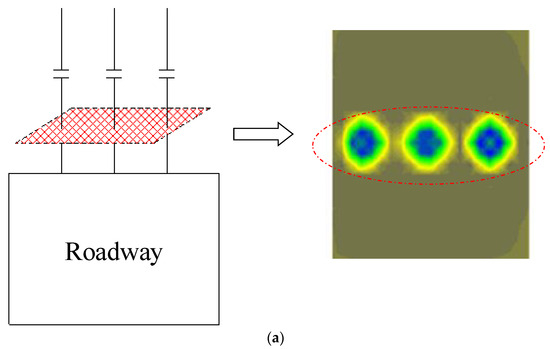
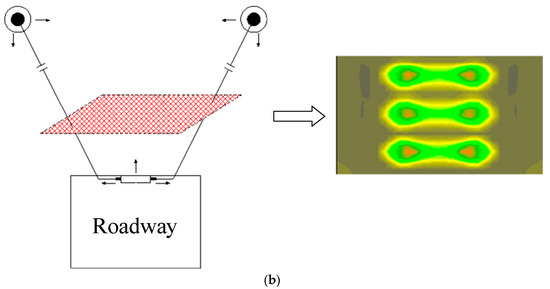
Figure 16.
Characteristics of prestress distribution of HSCTS support system and ordinary anchor cable. (a) Roof with a single, massive anchor cable; (b) Support structure for the HSCTS support system.
In the direction of the roadway, a strong prestressing layer is formed in the middle of the roof plate due to the connections between each prestressing zone. The prestressing zone is formed by the single-ring structure of the monolithic anchor cable. However, due to the formation of a narrow prestress belt, there is almost no prestress in the deep roof rock on both sides, resulting in high stress on the composite roof roadway. This makes the top plate susceptible to significant off-layer deformation and even sudden roof collapse.
- (3)
- Simulation of the support scheme analysis
Through numerical simulations, we conducted a comparative analysis between the traditional anchor cable support system and the HSCTS support system. The purpose of the analysis was to understand the stress distribution characteristics of the surrounding rock in the roadway, the expansion characteristics of the plastic zone, the stress state of the anchor cables, and the deformation patterns of the surrounding rock.
Based on the analysis of Figure 17a,b, we observed that regardless of the type of support system, the deformation of the surrounding rock gradually decreases as the roadway depth increases. However, the HSCTS support system showed a more uniform and symmetrical stress distribution in the roof and floor rock layers compared to the conventional support system. This suggests that the HSCTS support system has a significant impact on the stress distribution in the excavated roadway, resulting in symmetric and evenly distributed stress without concentration, which is beneficial for ensuring the stability of the surrounding rock.
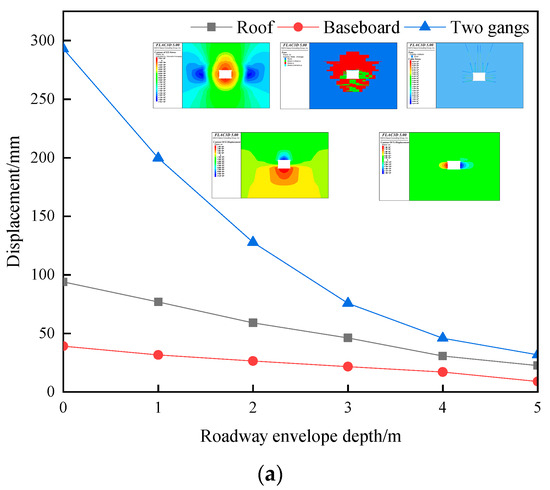
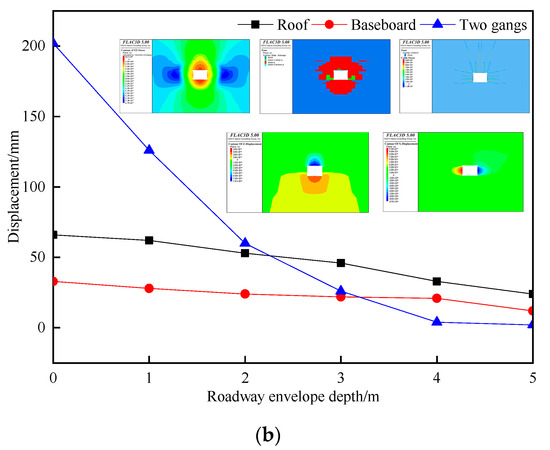
Figure 17.
Comparative effect of simulation of support scheme. (a) Simulation effect of ordinary anchor cable support scheme; (b) Simulated effect of HSCTS support scheme.
Moreover, after implementing the HSCTS support system with dual-anchor truss support for the roof, we observed a more uniform stress distribution as a whole. The deformation of the roof was significantly reduced under the combined action of the HSCTS support system, achieving overall control of the surrounding rock in the roadway. From the distribution of the plastic zone, we observed that except for the plastic zone at the roof-bottom corner of the roadway, the rest belonged to the same shear failure type, and the distribution range of the plastic zone in the HSCTS support system was significantly smaller. This indicates that it controls the further extension of the roadway surrounding rock failure towards the deep part of the rock mass, and the stress on the anchor cables is more symmetrical. The simultaneous interaction of the HSCTS support system and the surrounding rock in the roadway leads to uniform overall control of the roadway, thereby avoiding instability and failure caused by uneven stress distribution in localized areas.
Compared to the conventional support system, the HSCTS support system reduces roof subsidence by 30 mm, floor heave by 37 mm, and sidewall convergence by 115 mm. From these comparison results, we can see that the HSCTS support system reduces the deformation of the surrounding rock in the roadway to some extent. However, the reduction rate follows the order of roof subsidence, sidewall convergence, and floor heave. This indicates that the HSCTS support system has a more significant control effect on the roof, treating the roadway as a whole. Therefore, adopting the HSCTS support system can effectively ensure the stability of the surrounding rock in the roadway.
5. Field Application and Monitoring
5.1. Support Scheme
In collaboration with the high-strength double anchor cable truss support system on the top wall and the high preload, as depicted in Figure 18, I will assess the new support scheme and its specific requirements. Furthermore, I will analyze the deformation characteristics of the surrounding rock in the 1409 airway.
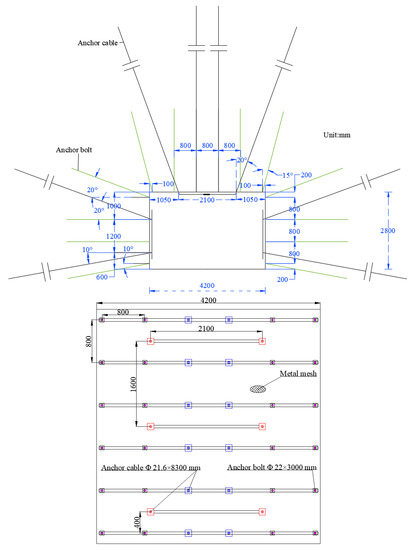
Figure 18.
Optimization of support scheme.
- (1)
- Roof support
To provide support for the roof, we use three bolts that are Φ 23 × 550 mm in size. These bolts are specifically designed for medium-speed resin roll anchorage. One of the bolts is a left-handed threaded, high-strength steel bolt that measures Φ 22 × 2500 mm and does not require longitudinal reinforcing.
The anchor bolts are placed in rows, with four bolts in each row. The distance between each bolt in a row is 800 mm. To ensure stability, there is a 15° angle between the roof angle anchor bolt and the vertical line near the coal wall. The remaining roof bolts are positioned vertically on the roof.
For additional support, we use anchor cables. The anchor cable support system combines single anchor cables and anchor cables for multi-dimensional structures. In each row, a single anchor cable is placed between every two rows of a multi-dimensional structure anchor cable. These two types of cables are organized alternately to provide comprehensive support for the roof.
① Single anchor cable
To install the anchor system, we will need a borehole with a diameter of 28 mm. We will use four anchoring cartridges and a prestressed steel strand with seven high-strength wires. The anchor cable will be 8.3 m long, and we will use resin for extending the anchoring. The anchoring length should be 2250 mm, and the anchor cable needs to be pre-tightened to at least 200 kN. The cartridges we will use are medium-speed resin cartridges with a diameter of 23 mm and a length of 550 mm. We will arrange two anchor cables in each row, with a row spacing of 800 mm.
② Anchor cable truss
For the anchor system, we will also need four medium-speed resin drug rolls measuring 23 mm by 550 mm. The prestressed steel strand will have seven high-strength wires and a diameter of 21.6 mm. The anchor cable will be 9.4 m long, and the anchor hole will be 8 m deep. The anchoring length will be 2250 mm. The bottom span of the anchor cable system will be 2.1 m, and the angle between the anchor cable drilling and the vertical line will be 20 degrees. The preload of the anchor cable should not be less than 200 kN. The anchor cable orifice will be located 1050 mm from the coal wall.
- (2)
- Roadway support
The road is supported by a combination of bolts, metal mesh, and steel belts.
① Bolt support
The anchor bolts used are medium-speed resin cartridge anchorages with a diameter of 23 mm and a length of 550 mm. The borehole diameter is 28 mm, and the anchoring length is 1650 mm. The side anchor bolt is tightened with a pre-tightening moment of at least 300 N·m. The anchor bolts used are high-strength anchor bolts with a diameter of 20 mm, made of silicon manganese steel, with left-handed threads.
There are four anchor bolts in each row, with an 800 mm gap between each row. The distance between the anchor bolts is also 800 mm. The top-side anchor bolt has an included angle of 20° with the horizontal plane. The two center anchor bolts are positioned horizontally, while the bottom anchor bolt has an included angle of −10° with the horizontal plane.
② Channel steel connection anchor cable support
For the anchor cable, a diameter of 28 mm and a length of 5.3 m are used. The anchor cable is inserted to a depth of 5.0 m with an anchorage length of 2250 mm. Alternatively, a diameter of 21.8 mm can be used with 19 strands of high-strength and high-elongation prestressed steel.
The channel steel used to link each row of two single anchor cables in the side anchor cables has a row spacing of 1600 mm. The upper anchor cable hole has an included angle of 20° with the horizontal line and is located 1.0 m from the top plate. The two anchor cable holes are separated by 1.2 m. The lower anchor cable’s drilling forms a −10° angle with the horizontal line, and the hole opening for the lower anchor cable is located 0.6 m from the bottom plate.
5.2. Field Monitoring Results
The results of field monitoring are presented in Figure 19. The largest values of BSRS (Bolt Stress Release System) for the depths of 8.5 m and 2.5 m in the roof strata are 44 mm and 36 mm, respectively. The values for the depths of 7.5 m and 1.5 m are no more than 54 mm and 51 mm, respectively. Initially, the general BSRS value changes rapidly in the first 10 days after the roadway excavation but then gradually stabilizes. The bearing loads of the bolts and cables are evenly distributed. Additionally, the difference between the loads on the bolts and cables is minimal. The combined effect of the bolt and cable support, along with the overall load-bearing structure, strengthens the control of the coal roadway.
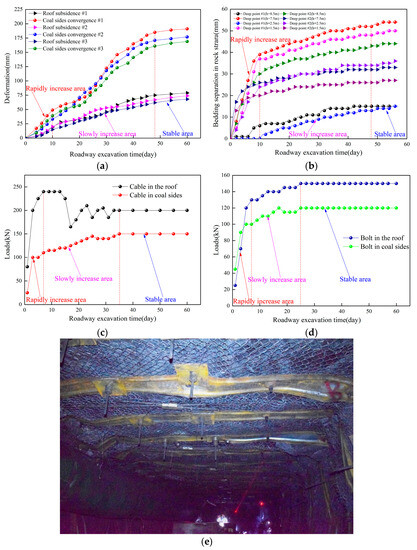
Figure 19.
Field application results. (a) surrounding rock deformation; (b) the BSRS; (c) cables loads; (d) bolts loads; (e) field support effect.
The subsidence of the roof and convergence of the two sides are both within acceptable limits, with maximum values of 79 mm and 191 mm, respectively, indicating minimal deformation during the two months of roadway excavation. The subsidence of the top plate generally corresponds to the downward movement of the neutral axis, which is effectively supported. The convergence of the two coal sides has two main stages of development. The first stage occurs within the first 15 days after excavation and then stabilizes. The second stage occurs between 25 and 40 days. Furthermore, the supporting structure remains stable and does not require any repairs during the roadway excavation, resulting in cost savings and reduced manpower requirements for specialized coal miners. Overall, the deformation of the surrounding rock is much smaller compared to the initial five supporting schemes, confirming the effectiveness of the supporting scheme with the core of the HSCTS (High-Strength Composite Truss Structure).
6. Discussion
This study thoroughly conducted the field observation and measurement of the roadway under difficult production conditions and proposed the supporting technology for the core of the HSCTS. For the surrounding rock stability of the underground coal roadway, the proper layout of the coal roadway is also significantly important, so lots of literature pays more attention to the correlation between the roadway layout and ground stress distribution characteristics, especially when combined with the mining-induced horizontal and vertical stress distribution after the working face advanced [9,13,19,20]. The narrow pillar or much wider, narrower pillar could avoid the high mining-induced stress, so it is beneficial to the stability of the roadway. However, with the special production and geological conditions, the layout of the roadway is under the high-stress zone of the goaf of panels #10209 and #1411, which leads to the LIMIS. In the limited space of this paper, we will continue to thoroughly study the mining-induced stress distribution characteristics as working faces 10209 and 1411 advance and the proper roadway layout in combination with the advanced numerical simulation and large physical modeling experiment.
The safeguard to the stability of the roadway layout in the high-stress distribution zone is commonly a tough problem [10,12]. If there is no proper supporting technology, a large deformation will accompany the roadway excavation. Related literature mainly focuses on the mining-induced stress influence on the surrounding rock stability caused by the nearby working face advancing [18,25]. However, this production situation with nearby two working faces advancing in this study is much more complex than one working face advancing, as has been significantly testified by multiple supporting scheme adjustments with the roadway excavation.
For the excavated roadway with very difficult production conditions, the traditional simple growth of the bolts or cable number proved not to be an effective method. Further, a useful supporting structure is much more important than the supporting number. In addition, the integrity of the roof strata could be affected by the decrease in bolt or cable spacing. As a result of this difficult condition, the HSCTS was used to control the bedding separation in the roof strata and surrounding rock displacements. Actually, this supporting system was developed from the initial bolt truss support and then conventional cable truss support [10,12,22,26]. In combination with the higher anchoring force afforded by the capsule resin, the higher strength property of the larger diameter cable, and a more reliable lockset to the roof than conventional roof cable trusses, the supporting structure could afford strong shear and tensile resistance to the high mining-induced stress. Most importantly, this structure helps coordinate the deformation among the roof, coal sides, and floor, resulting in a large reduction of the surrounding rock deformation. Furthermore, the large difference in loading force between the bolt and cable is greatly decreased, and a good, combined effect is also achieved. In all, the surrounding rock stability of the difficult excavated coal roadway in this study has been successfully safeguarded, and there are no repairing activities after the roadway excavation as a limited deformation occurs along with the working face 1409.
7. Conclusions
In this study, the deformation and damage characteristics of the rock surrounding the roadway caused by the original support scheme’s high stress concentration area (HSCA) were examined, and a high-preload HSCTS support technology was innovatively suggested. The distribution properties of the roadway’s high stress concentration area and the distribution law of the truss anchor cable pre-stress are determined using numerical simulation, and the control mechanism is investigated through mechanical analysis. The key findings are as follows: after simulating the impact of the new support scheme, determining its exact parameters, and field-verifying it, the new support scheme uses HSCTS as its core.
- (1)
- The damaged types of the supporting structures and the deformation characteristics are concluded as follows: a. Six damaged supporting types are mainly obtained: broken bolt and cable, loose bolt and cable, tearing steel belt, and curved steel beam. b. Both the BSRS and the associated growth rate are generally large. c. Large deformations of surrounding roadways occur without the proper supporting scheme and have to face multiple repair activities during the roadway excavation period. d. The bolts and cables bearing loads have a large difference during the roadway excavation process, and the cables suffer from extreme high stresses, resulting in the combined bolt and cable supporting effect being weak and cables and bolts damaged in sequence.
- (2)
- Based on the difficult supporting roadway affected by the HSCA, the HSCTS support is put forward, and the main supporting effects and superiority are analyzed. Moreover, the supporting stress distribution characteristics were simulated, which showed the stress distribution field of the HSCTS is uniform and could benefit from forming a stable structure.
- (3)
- The supporting scheme with the core of the HSCTS and detailed parameters of the airway 1409 are determined and tested in the field; the findings indicate that the maximum value of shallow delamination is 44 mm, the maximum value of deep delamination is 54 mm, the top plate is not sinking more than 79 mm, and the two gangs are not moving in close proximity to one another more than 191 mm; and the monitoring results showed the surrounding rock deformation is much smaller than the former scheme with no repairing activities and testified to the significant supporting effect.
The findings could help to understand the surrounding rock deformation characteristics of the excavated coal roadway distributed in areas with the LIMIS. Furthermore, the designed supporting scheme has successfully safeguarded the surrounding rock’s stability. Furthermore, this supporting case could afford a general reference for the similar geological and production conditions; however, the detailed parameters should be determined with the field roadway with the special geological or production condition.
Author Contributions
Software, L.T.; Investigation, H.Y.; Data curation, Y.C.; Writing—original draft, Z.X.; Writing—review & editing, C.L. All authors have read and agreed to the published version of the manuscript.
Funding
National Natural Science Foundation of China (NSFC): 51874277.
Data Availability Statement
The datasets used and/or analyzed during the current study available from the corresponding author on reasonable request.
Conflicts of Interest
The authors declare no conflict of interest.
References
- Wu, Q.; Tu, K.; Zeng, Y.; Liu, S. Discussion on the main problems and countermeasures of building an upgraded version of China’s main energy (coal). J. Coal Ind. 2019, 44, 1625–1636. [Google Scholar]
- Yang, R.; Li, Y.; Guo, D.; Zhu, Y.; Yao, L.; Yang, T.; Yu, X. Reasons for deformation and failure of deep high stress soft rock roadway and support technology. J. Min. Saf. Eng. 2017, 34, 1035–1041. [Google Scholar]
- Li, C.; He, S.; Chen, L. Study on the mechanism and control measures of unsymmetrical roof fracture in large-span fault crossing soft rock roadway. J. Min. Saf. Eng. 2021, 38, 1081–1090. [Google Scholar]
- Xia, Y.; Pan, J.; Xie, F.; Feng, M.; Liu, S.; Lu, C. Disaster causing mechanism and control technology of repeated impact in the composite structural area of the main roadway in extra thick coal seam. J. Rock Mech. Eng. 2022, 41, 1–10. [Google Scholar]
- Zhang, J.; Yuan, R.; Li, Y. Study on surrounding rock control technology of thick mudstone composite roof coal roadway. J. Rock Mech. Eng. 2017, 36, 152–158. [Google Scholar]
- Kang, H.; Jiang, P.; Huang, B. Cooperative control technology of surrounding rock support—Modification—Pressure relief in 1000 meter deep mine roadway. J. Coal Ind. 2020, 45, 845–864. [Google Scholar]
- He, M.; Guo, Z. Mechanical properties and engineering application of constant resistance large deformation anchor. J. Rock Mech. Eng. 2014, 33, 1297–1308. [Google Scholar]
- Wang, Q.; Jiang, B.; Pan, R.; Li, S.C.; He, M.C.; Sun, H.B.; Qin, Q.; Yu, H.-C.; Luan, Y.-C. Failure mechanism of surrounding rock with high stress and confined concrete support system. Int. J. Rock Mech. Min. Sci. 2018, 102, 89–100. [Google Scholar] [CrossRef]
- Wang, Q.; Jiang, B.; Li, S.C.; Wang, D.C.; Wang, F.Q.; Li, W.T.; Ren, Y.X.; Guo, N.B.; Shao, X. Experimental studies on the mechanical properties and deformation & failure mechanism of U-type confined concrete arch centering. Roadwayl. Undergr. Space Technol. 2016, 51, 20–29. [Google Scholar]
- Liu, G.; Lin, Q.; Zhang, X. Stability analysis of surrounding rock supported by steel tube concrete support in high stress roadway. J. Shandong Univ. Technol. Nat. Sci. Ed. 2017, 31, 13–16. [Google Scholar]
- Xia, H.; Liu, G.; Liu, J.; Zhang, X.; Tian, T. Performance test of steel tube concrete support and its application in dynamic pressure roadway support. Coal Mine Saf. 2013, 44, 146–149. [Google Scholar]
- Yan, H.; He, F.; Xu, T. Research and practice on control system of double anchor cable truss in large section coal roadway of deep mine. J. Rock Mech. Eng. 2012, 31, 2248–2257. [Google Scholar]
- Wang, L.; Wang, Q.; Huang, Y.; Zhang, H.; Jiang, B.; Xu, Y.; Lu, W. Research on deformation mechanism and support technology of deep high stress cross seam roadway. J. Min. Saf. Eng. 2019, 36, 112–121. [Google Scholar]
- He, Z.; Chen, G. Research on Prestressed Cooperative Support Technology of Deep Roadway in Coal Mine. Coal Sci. Technol. 2013, 41, 35–38. [Google Scholar]
- Yuan, C. Study on Deformation and Failure Mechanism and Stability Control Principle of Surrounding Rock of Deep Roadway. Ph.D. Thesis, Hunan University of Science and Technology, Xiangtan, China, 2017. [Google Scholar]
- Yu, Y.; Bai, J.; Wang, X.; Wu, L.F.; Zhang, L.Y.; Xia, H.C. Research on layout and pressure relief control of roadway with residual coal pillar mining face. J. China Coal Soc. 2020, 45, 49–59. [Google Scholar]
- Wu, X.Y.; Liu, H.T.; Li, J.W.; Guo, X.F.; Lv, K.; Wang, J. Temporal-spatial evolutionary law of plastic zone and stability control in repetitive mining roadway. J. China Coal Soc. 2020, 45, 3389–3400. [Google Scholar]
- Gao, F.Q.; Stead, D.; Kang, H.P. Numerical simulation of squeezing failure in a coal mine roadway due to mining-induced stresses. Rock Mech. Rock Eng. 2015, 48, 1635–1645. [Google Scholar] [CrossRef]
- Suchowerska, A.M.; Merifield, R.S.; Carter, J.P. Vertical stress changes in multi-seam mining under supercritical longwall panels. Int. J. Rock Mech. Min. Sci. 2013, 61, 306–320. [Google Scholar] [CrossRef]
- Suchowerska, A.M.; Carter, J.P.; Merifield, R.S. Horizontal stress under supercritical longwall panels. Int. J. Rock Mech. Min. Sci. 2014, 70, 240–251. [Google Scholar] [CrossRef]
- Su, J.M.; Jiang, L.S.; Kong, P.; Wang, P.; Zhang, P.P. Numerical modeling approach on mining-induced strata structural behavior by considering the fracture-weakening effect on rock mass. Appl. Sci. 2019, 9, 1832. [Google Scholar]
- Li, Y.; Lei, M.X.; Wang, H.S.; Li, C.; Li, W.W.; Tao, Y.; Wang, J.Y. Abutment pressure distribution for longwall face mining through abandoned roadways. Int. J. Min. Sci. Technol. 2019, 29, 59–64. [Google Scholar] [CrossRef]
- Gao, R.; Yu, B.; Meng, X.B. Stress distribution and surrounding rock control of mining near to the overlying coal pillar in the working face. Int. J. Min. Sci. Technol. 2019, 29, 881–887. [Google Scholar] [CrossRef]
- Yang, W.; Lin, B.Q.; Yan, Q.; Zhai, C. Stress redistribution of longwall mining stope and gas control of multi-layer coal seams. Int. J. Rock Mech. Min. Sci. 2014, 72, 8–15. [Google Scholar] [CrossRef]
- Zhao, Y.; Luo, S.; Wang, Y.; Wang, W.; Zhang, L.; Wan, W. Numerical Analysis of Karst Water Inrush and a Criterion for Establishing the Width of Water-resistant Rock Pillars. Mine Water Environ. 2017, 36, 508–519. [Google Scholar] [CrossRef]
- Zhao, Y.; Liu, Q.; Zhang, C.; Liao, J.; Lin, H.; Wang, Y. Coupled seepage-damage effect in fractured rock masses: Model development and a case study. Int. J. Rock Mech. Min. Sci. 2021, 144, 104822. [Google Scholar] [CrossRef]
- Zhao, Y.; Zhang, C.; Wang, Y.; Lin, H. Shear-related roughness classification and strength model of natural rock joint based on fuzzy comprehensive evaluation. Int. J. Rock Mech. Min. Sci. 2020, 137, 104550. [Google Scholar] [CrossRef]
- Yu, W.; Li, K.; Liu, Z.; An, B.; Wang, P.; Wu, H. Mechanical characteristics and deformation control of surrounding rock in weakly cemented siltstone. Environ. Earth Sci. 2021, 80, 337. [Google Scholar] [CrossRef]
- Sakhno, I.; Sakhno, S. Numerical Studies of Floor Heave Control in Deep Mining Roadways with Soft Rocks by the Rock Bolts Reinforcement Technology. Adv. Civ. Eng. 2023, 2023, 2756105. [Google Scholar] [CrossRef]
- Guo, G.; Kang, H.; Qian, D.; Gao, F.; Wang, Y. Mechanism for Controlling Floor Heave of Mining Roadways Using Reinforcing Roof and Sidewalls in Underground Coal Mine. Sustainability 2018, 10, 1413. [Google Scholar] [CrossRef]
- Tahmasebinia, F.; Yang, A.; Feghali, P.; Skrzypkowski, K. Structural Evaluation of Cable Bolts under Static Loading. Appl. Sci. 2023, 13, 1326. [Google Scholar] [CrossRef]
- Tahmasebinia, F.; Yang, A.; Feghali, P.; Skrzypkowski, K. A Numerical Investigation to Calculate Ultimate Limit State Capacity of Cable Bolts Subjected to Impact Loading. Appl. Sci. 2023, 13, 15. [Google Scholar] [CrossRef]
- Yin, S.; Cai, W.; He, F.; Tian, D.; Shi, H. Mechanism and application of parallel-arranged composed of truss cable and single cable with high preload. J. China Univ. Min. Technol. 2014, 43, 823–830. [Google Scholar]
- Kang, X.; Zhao, H.; Xue, J. Theoretic analysis for hooping mechanism and composite elastic modulus of CFST members. Eng. Mech. 2007, 24, 121–125. [Google Scholar]
Disclaimer/Publisher’s Note: The statements, opinions and data contained in all publications are solely those of the individual author(s) and contributor(s) and not of MDPI and/or the editor(s). MDPI and/or the editor(s) disclaim responsibility for any injury to people or property resulting from any ideas, methods, instructions or products referred to in the content. |
© 2023 by the authors. Licensee MDPI, Basel, Switzerland. This article is an open access article distributed under the terms and conditions of the Creative Commons Attribution (CC BY) license (https://creativecommons.org/licenses/by/4.0/).